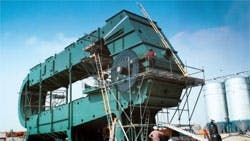Chain drive powers large load in oil extractor
Gigantic machines, some as high as a four-story building, are used to separate oil from the humble bean. Called extractors, these machines use powerful chain drives in a process that extracts vegetable oils from a variety of seeds and beans including soybeans, cottonseed, wheat germ, sunflower seeds, and coffee beans.
In operation, the beans or seeds enter through a hopper on top of the extractor and are deposited on a chain-driven flight conveyor. As the conveyor moves the material through the machine, a series of solvent washes separates the oil from the solids. During extraction, the oil concentration in the oil-solvent mixture gradually increases to about 25%. The oilrich liquid discharges from the machine through a hydroclone scrubber that removes the remaining fine particles before the mixture is pumped to a distillation system.
Powerful, but simple drives
Oil-processing plants typically handle a large amount of soybeans or other oil seeds — 1,000 to 4,000 tons per day . Because of this, it is generally more efficient to process the material with one large extractor rather than several small ones. But the size of these machines and the weight of the material they process presents a unique challenge to the drives that move the material through the machine — they must transmit high torques, well over 1 million lb-in., and operate at low speeds, less than 1 rpm.
Engineers at Crown Iron Works Co., Minneapolis, find that a chain drive is easier to customize to application requirements and is less expensive than using a gearbox for speed reduction. Accordingly, they developed a large multistage chain and sprocket arrangement powered by a small motor to drive the extractor mechanism.
Largest extractor goes to England
One of several extractors recently built for use in England tops them all. Designed to extract cooking oil from raw canola beans, the huge machine delivers 2.5 million lb-in. torque and processes up to 4,000 tons of beans per day.
This extractor has a large roller-type chain drive. The drive consists of a 30-hp adjustable-speed motor with a small gearbox, and two roller chain speed-reduction stages terminating at a driven sprocket that is over 12-ft diameter. The roller chain has a 6-in. pitch and 3-in diameter rollers with 4-in. high by 3/4-in. thick sidebars.
The chain drive simultaneously steps up the torque from 1,400 lb-in. at the motor to 2.5 million lb-in. at the driven sprocket and slows the speed from 450 rpm at the motor to a virtual crawl (1/4 rpm) at the driven end. Motor speed is controlled by the volume of solid materials being conveyed as read by an electronic sensor.
The driven sprocket on the outside of the machine powers a special conveyor consisting of two or more inboard sprockets mounted on the same shaft and an internal conveyor chain with vertical links that move the material (beans or seeds) through the machine.
The chain incorporates a large safety factor (420,000-lb ultimate strength vs. about 42,000-lb pull load) to prevent chain breakage. This large safety factor, in combination with the lowspeed operation, simplifies chain drive maintenance. The drive requires only a small amount of lubrication, which is generally applied by drip feed, spray, or brush. Also, the chain requires little or no tension adjustment. In most cases, a rubber-faced idler on the high-speed stage applies the needed tension.
World’s largest sprocket
Chain sprockets for the largest English machine were built by Martin Sprocket & Gear Inc., Arlington, Texas. The driven sprocket was especially challenging — it was too large to manufacture from one piece of steel. And, it would have been too difficult to ship and handle conveniently.
Therefore, Martin built a fabricated sprocket from three circular outer ring segments that were bolted to each other through splice plates on the side and then bolted to a center hub. Said to be the largest of its kind, the entire sprocket assembly is 12.66 ft diameter, and weighs 17,453 lb. It has a 15-in. bore with a 2 x 3/4-in. keyway. Teeth were individually flame cut and milled to accommodate the 6-in. pitch roller chain. Because of its size and weight, the sprocket was shipped disassembled so that it could be reassembled on site as it was being installed on the shaft high up on the machine.
